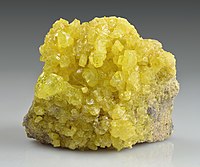
Photo from wikipedia
Abstract The effects of different atmospheres on the distribution of organic and inorganic sulphur compounds during high-pyrite coal pyrolysis were investigated. Sulphur compound releases were determined by atmospheric pressure-temperature programmed… Click to show full abstract
Abstract The effects of different atmospheres on the distribution of organic and inorganic sulphur compounds during high-pyrite coal pyrolysis were investigated. Sulphur compound releases were determined by atmospheric pressure-temperature programmed reduction (AP-TPR) “on-line” coupled with MS and AP-TPR “off-line” coupled with TD-GC/MS, which is a reliable technique for coal sulphur characterization. The results show that the decomposition of both organic and inorganic sulphur is different in the three applied atmospheres: H2, N2 and CO2. In H2, most sulphur from LZ coal is hydrogenated/reduced to H2S, decomposition of inorganic sulphur (pyrite and sulphates) has a great effect on the formation of H2S. It not only enhances the intensity of its m/z 34 signal but also shifts the peak maximum of its profile to a higher temperature, even without a returning to the base line. In inert N2 gas, as expected, hydrogenation of some sulphur compounds such as less-reactive di-aryl sulphur species and simple thiophenic structures are highly limited. The dominant peak of m/z 34 can also be related to the reduction of pyrite. In CO2, coal sulphur is mainly converted into SO2/SO, because CO2 is a more reactive gas and rather acts as an oxidizing agent. Decomposition of organic sulphonic acids occurs before 500 °C and of sulphonics/sulphoxides after 500 °C. The decomposition of sulphates and pyrite is better detectable in CO2 than in inert gas atmosphere. After 800 °C char gasification in CO2 results in further decomposition of sulphur compounds and lower sulphur retention.
Journal Title: Fuel
Year Published: 2017
Link to full text (if available)
Share on Social Media: Sign Up to like & get
recommendations!